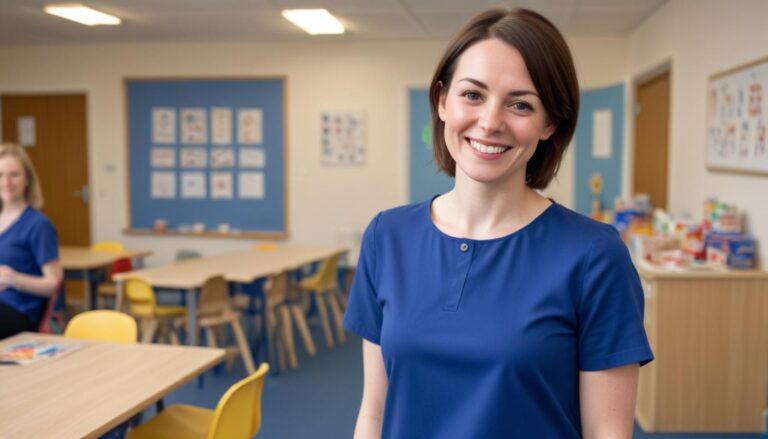Summary
- Selecting appropriate stories and rhymes for children aged 0-5 years 11 months is vital for their language development and emotional growth.
- Stories help expand vocabulary, improve listening skills, and foster empathy through diverse perspectives.
- It’s important to choose age-appropriate content that is interactive, culturally relevant, and educational, ensuring children are engaged and learning.
- Involving families in storytelling can strengthen home learning, with workshops helping parents understand how to incorporate stories into daily routines.
This guide will help you answer 2.1. Identify stories and rhymes for children 0-5 years 11 months.
Selecting the right stories and rhymes for young children can have a significant impact on their development. As an early years practitioner, your role is to engage and nurture young minds through language, story, and rhythm. In this guide, we will look at how to identify appropriate stories and rhymes for children aged 0-5 years 11 months.
What are Stories and Rhymes?
Stories and rhymes are instrumental in developing language skills, creativity, and emotional intelligence. They help children learn new words, understand rhythm and rhyme, and develop listening and concentration skills.
Language Development
- Vocabulary Expansion: Stories introduce new words in context, helping children understand and use them.
- Sentence Structure: Listening to stories familiarises children with the way sentences are constructed.
- Phonemic Awareness: Rhymes highlight sound patterns and sequences, aiding in phonemic awareness and early reading skills.
Emotional and Social Skills
- Empathy: Stories allow children to see the world from different perspectives.
- Social Interaction: Group storytelling and rhyming encourage social participation and turn-taking.
Age-Appropriate Stories and Rhymes
Babies (0-12 Months)
Characteristics
- Simple text
- Bright, high-contrast illustrations
- Interactive elements (textures or flaps)
Suggested Titles
- “That’s Not My…” Series by Fiona Watt: These are sensory books that engage babies with touch.
- “Peek-A-Boo!” by Anne Braun: Encourages interaction through lifting flaps.
Recommended Rhymes
- Nursery Rhymes: Simple, repetitive songs like “Twinkle, Twinkle, Little Star” and “Row, Row, Row Your Boat”.
- Action Rhymes: Short rhymes with actions, such as “Pat-a-cake”.
Toddlers (1-2 Years)
Characteristics
- Rhyming texts
- Repetitive phrases
- Simple storylines
Suggested Titles
- “Dear Zoo” by Rod Campbell: Engages curiosity with flaps and simple text.
- “Brown Bear, Brown Bear, What Do You See?” by Bill Martin Jr. and Eric Carle: Uses repetition to build anticipation and helps with colour recognition.
Recommended Rhymes
- “The Wheels on the Bus”: Interactive with different verses.
- “Five Little Ducks”: Encourages counting and participation.
Preschoolers (3-5 Years)
Characteristics
- More complex plots
- Varied vocabulary
- Moral or educational themes
Suggested Titles
- “The Gruffalo” by Julia Donaldson: A fun story with rhyme and rhythm.
- “Room on the Broom” by Julia Donaldson: Explores ideas of friendship and cooperation.
Recommended Rhymes
- “This Old Man”: Rhyming with numbers.
- “Old MacDonald Had a Farm”: Encourages participation and animal sound recognition.
Selecting the Right Content
Cultural Relevance
Ensure that the stories and rhymes are inclusive and reflective of diverse cultures. This approach can help to foster an inclusive environment where children feel seen and valued.
Interactivity
Choose stories that include interactive elements. Flaps, textures, and sound effects can make storytime more engaging.
Educational Value
Consider the educational aspects of stories and rhymes. Look for content that can teach counting, colours, animal names, and moral lessons.
Incorporating Stories and Rhymes
Storytime Sessions
- Routine: Create a routine so children know what to expect.
- Participation: Encourage children to join in with actions or repetitive lines.
- Discussion: After reading, discuss the story, asking questions to help children think critically about what they’ve heard.
Rhyming Games
- Sing-Alongs: Use familiar tunes and encourage children to sing.
- Movement: Pair rhymes with movements to engage physical development.
Creating a Resource Library
Essentials for a Resource Library
- Variety: Include books and rhymes that cater to all ages from 0 to 5.
- Access: Ensure resources are accessible to children, with low shelves and comfortable reading areas.
- Updates: Regularly update the library to include new titles and materials.
Online and Multimedia Resources
- Audiobooks: Provide options for listening to stories during quiet time.
- Interactive Apps: Use educational apps that include interactive stories and rhymes.
Supporting Diverse Needs
Children with Special Educational Needs (SEN)
- Sensory Books: These books can be tailored for children with sensory processing needs.
- Simplified Language: Offer stories with simplified language to aid understanding.
English as an Additional Language (EAL)
- Bilingual Books: Use books that display text in both English and the child’s home language.
- Music and Rhyme: Music transcends language barriers and is a universal way of engaging with children.
Engaging Families
Involving Parents
Encourage parents to share favourites from their childhood. It strengthens home-learning environments and promotes language development outside of the setting.
Workshops
Offer workshops for parents to learn about the benefits and techniques of storytelling and more ways to include it in daily routines.
Final Thoughts
Stories and rhymes play an integral role in the development of children aged 0-5 years 11 months. As an early years practitioner, selecting the right material is essential for supporting young children’s growth across various developmental areas. By carefully considering the age-appropriateness, interactivity, cultural relevance, and educational value, you provide a rich learning experience that can open up a world of imagination and learning for the children in your care.
Subscribe to Newsletter
Get the latest news and updates from Care Learning and be first to know about our free courses when they launch.







